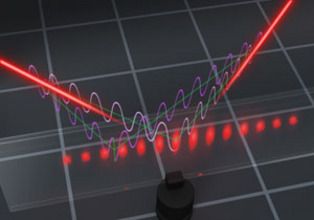"Quantum rulers" offer greater precision… and now we know how much greater
2012-09-20

The scientists from the Faculty of Physics, University of Warsaw, and the University of Nottingham, have developed theoretical tools making it possible to establish the limits of the precision actually attainable using entangled states under realistic experimental conditions. This has enabled current experimental achievements in the field of precision measurements to be compared, for the first time, against the fundamental limitations of quantum mechanics.
Interferometric measurements, utilizing light interference, are among the most precise measuring methods known to modern science, finding application in such fields as astronomy, telecommunications, biology, and medicine. Probably the most intriguing application is their use in gravitational-wave detectors, where the phenomenon of interference between strong beams of light is harnessed as a way to try to detect gravitational waves of amplitudes smaller than the size of a proton.
However, it turns out to be possible to further boost the sensitivity of interferometers by using specially prepared quantum states of light in which quantum entanglement plays a significant role. Entanglement is a unique phenomenon in quantum physics and underlies such ideas as quantum teleportation, quantum cryptography, and quantum computers. When photons, which are elementary portions of energy carried by light, are brought into an entangled state they exhibit very strong correlations that are not observed in generally available natural or artificial sources of light. As a result, entangled photons may exhibit behavior that is analogous to photons comprising light of significantly shorter wavelength, and therefore support measurements of higher precision.
If we think of an individual photon as a "quantum ruler" with a precision of 1 mm, by preparing 10 photons in an appropriate entangled state we can in theory obtain a "ruler" with intervals of 0.1 mm, gaining a tenfold improvement in precision. However, that is just in theory: quantum entanglement is extraordinarily sensitive to all kinds of experimental imperfections and one of the fundamentally unresolved issues has to date been to what extent this theoretically-possible quantum improvement in precision may be useful in practice.
Dr. Rafał Demkowicz-Dobrzański and Jan Kołodyński from the Faculty of Physics, University of Warsaw, in collaboration with Madelin Guta from the University of Nottingham, have developed theoretical tools making it possible to establish the limits of the precision actually attainable using entangled states under realistic experimental conditions. This has enabled current experimental achievements in the field of precision measurements to be compared, for the first time, against the fundamental limitations of quantum mechanics.
Already for several years now, modern gravitational-wave detectors have been taking preliminary measurements using quantum states of light in an attempt to boost their precision. One of the basic practical techniques involves interference using light in what is known as a "squeezed vacuum" state. Using new theoretical tools, the measurement scheme currently in use was proven to be optimal. We can therefore safely say that in the field of gravitational-wave detection we are close to reaching the limits of precision permitted by the laws of quantum mechanics. Will this finding help us detect the elusive gravitational waves at long last? That should become clear within the next few years.
The results were published in the September issue of the renowned journal Nature Communications. The research was funded under the TEAM project "Photonic implementations of technologies using quantum effects" of the Foundation for Polish Science, the Q-ESSENCE (Quantum interfaces, sensors, and communication based on entanglement) project funded under the 7th EU Framework Programme and coordinated by the University of Warsaw, and the QUASAR (Quantum States: Analysis and Realizations) project funded under the ERA-NET and CHIST-ERA program.
Publication:
R. Demkowicz-Dobrzanski, J. Kolodynski & M. Guta, The elusive Heisenberg limit in quantum-enhanced metrology, Nature Communications 3, 1063 (2012)





